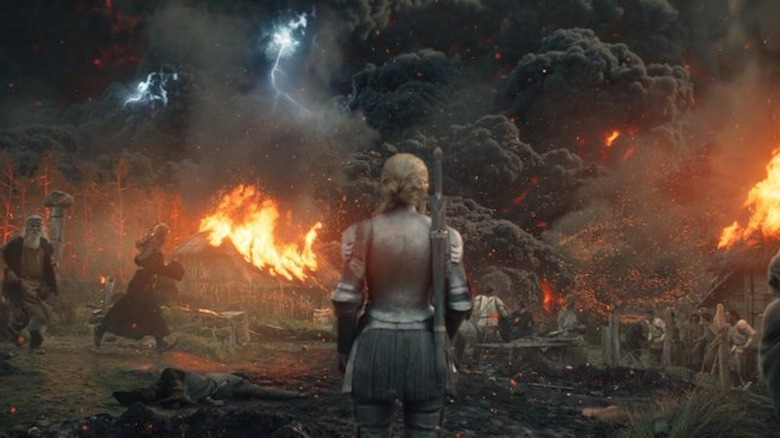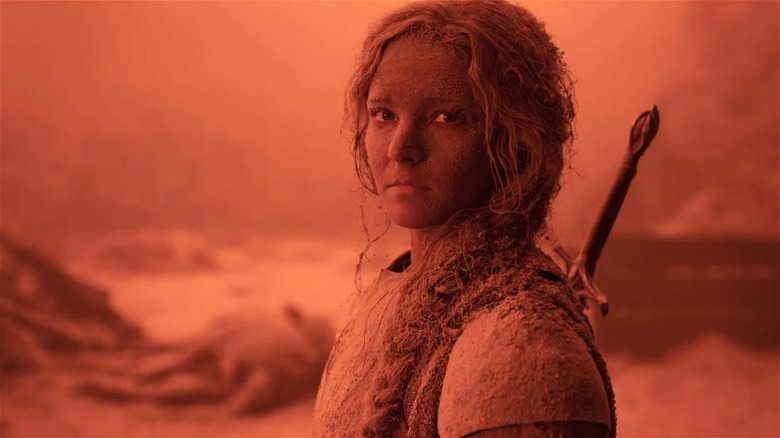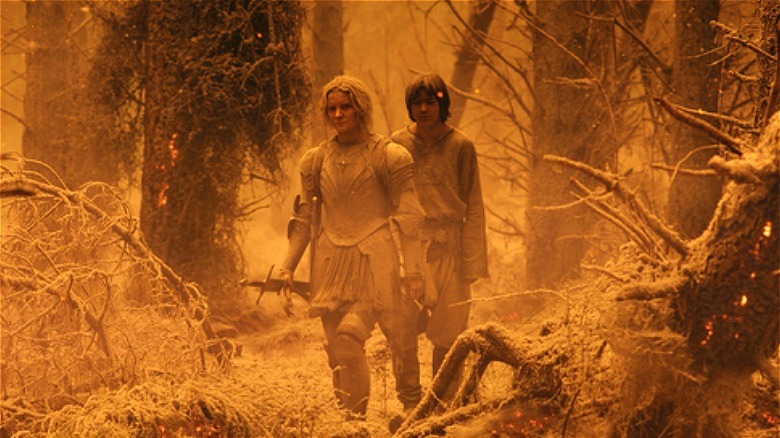A 'Huge Amount' Of The Rings Of Power's Volcanic Aftermath Was Filmed Practically, Without Green Screen [Exclusive]
This post contains spoilers for "Lord of the Rings: The Rings of Power."
After things quite literally heated up with the creation of Mordor in Episode 6 of "The Rings of Power," Episode 7, titled "The Eye," has taken its time to allow things to settle down. The latest episode starts with the aftermath of the volcanic eruption in the Southlands, which brings about much death and destruction and sets the stage for key events to occur. The visual aspect of the volcanic eruption triggered by Sauron's hilt has been woven beautifully, as these visceral scenes act as a presage for the horrors that are about to engulf Middle-earth.
In a recent interview with "Rings of Power" director of photography Alex Disenhof, /Film's Vanessa Armstrong spoke to him about the technical aspects that contributed to the show's stunning lighting, camera angles, and cinematography. In this interview (which you can read here), Disenhof explained that no green or blue screens were used to achieve the effect of the volcanic aftermath and that a lot of research went into staging the scenes:
"What you see in the finished product is a huge amount of it is practical — the color itself is straight out of camera. There's very little color correction...And the visual effects team added the chaotic ashes flowing through and sparks...We also surrounded the set with muslin instead of green screen, and with the atmosphere that we had, the very heavy atmosphere, it had a natural fall-off into this hazy depth, which the visual effects team could then augment using shapes of burned-out buildings in the far background. There was no blue or green screen for any of those sequences."
Let us dig deeper into the scenes in question.
Creating hell on earth
"Lord of the Rings" fans immediately understood the significance of the volcanic eruption, as Mount Doom would eventually become the site for the creation and destruction of the One Ring. Even though the characters of the show are currently unaware of the degree of doom that accompanies the creation of Mordor, they're aware that this incident marks a turning point in Middle-earth history. The Southlands are no more; the people are broken and unmotivated, and their king (Halbrand), who took up his royal mantle after much consideration, is grievously wounded at the moment. Additionally, the orcs are a bigger threat than ever, as they can now move around in sunlight, and the mighty Númenóreans feel deep regret in their decision to follow Galadriel (Morfydd Clark) into battle.
Disenhof and his team understood the weight of the event, which made it crucial for them to evoke imagery that was true to real-life environmental disasters and their effect on wildlife. This helped shape the kinds of effects that were to be used in these scenes, such as the terrifying red hue used in the opening sequences, in which Galadriel and the others are covered in hazardous volcanic ash. Disenhof explained how real-life research greatly informed the post-disaster visuals:
"What struck me in those [real-life] instances was the color of the sky and the color of the atmosphere — we decided that it should look like hell on Earth, like the middle of a wildfire. We knew we needed to have control of the atmosphere and control of the color of the light as much as possible for the bulk of our scenes. So we rebuilt the now-ruined village on stage, and we tested for weeks with different color lights and figured out what combination look good."
Capturing the grief and quiet terror of the aftermath
Clearly, a lot of research and care went into the practical effects and cinematography of the opening scenes of "The Eye," and this is reflected in the transition from the epicenter of the eruption to comparatively safer areas. As soon as Galadriel wakes up, she's disoriented by the catastrophe that surrounds her, as the village is on fire, and its inhabitants (along with some of the Númenóreans) are either injured, traumatized, or dead. The chaos of the scene is heightened by the red hue used throughout, which gradually fades as the characters make it through the forest to camp.
Disenhof also explained that it was tricky to achieve a smooth transition from the heart of danger to safer areas, as there was little control over the light and atmosphere of the forest scenes. The issue was resolved with the aid of camera filters and slight color correction to maintain consistency:
"To compensate for the fact that we didn't have as much control, we used filters in the camera, and we did some color correction and we worked with our special effects/visual effects department to combine all that together to match those sequences...As they get further and further away, I used different filters in the cameras to peeled back the look a little bit to make it less intense and less intense, until finally our characters are out of it."
The visual feats achieved by these sequences in "The Eye" truly warrant praise, especially considering that they were mostly practical in nature. I cannot wait to check out the visual aspects of potential battle/kinetic sequences in the show in the near future.
"The Lord of the Rings: The Rings of Power" drops a new episode every Friday on Prime Video.


